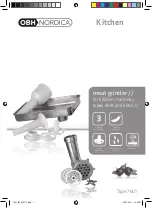
20
Temperature Conversion Chart
Centigrade
Fahrenheit
C
F
40
104
45
113
50
122
55
131
60
140
65
149
70
158
75
167
80
176
Meats, Fish, and Poultry
Dried meats are best when made for upcoming camping and backpack-
ing trips. When reconstituted, they yield a tasty meat, somewhat like fresh
cooked.
Use only very lean meats and cut away as much fat as possible. Meat
should be marinated before drying to add flavor and also to tenderize it. The
marinade should contain salt, which helps extract water from the meat and
also helps preserve it and should not have any oil. Most marinades contains
some sort of acid (like tomato sauce or vinegar) because the acid breaks
down the fibers making the meat more tender.
Slicing meat while partially frozen will be easier, especially if you want
very thin slices. A food processor or a specialized meat slicer can do a great
job. You can also tell your butcher that you are making dried meat or jerky
and they will be glad to thin slice it for you.
When drying meat or game for stews, soups, etc. Remember that these
types of meats must be cooked prior to drying. Cook, cut into small cubes
and place in the dehydrator. Dry until all moisture had been removed, ap-
proximately 2 to 8 hours.
When ready to use in your favorite stew, simply rehydrate by soaking
in water or broth for at least 1 1/2 hours or until tender and about the size
they were before dehydrating.
Beef
• Choose lean cuts. Beef flank steak, round or rump are better than
chuck or rib.







































